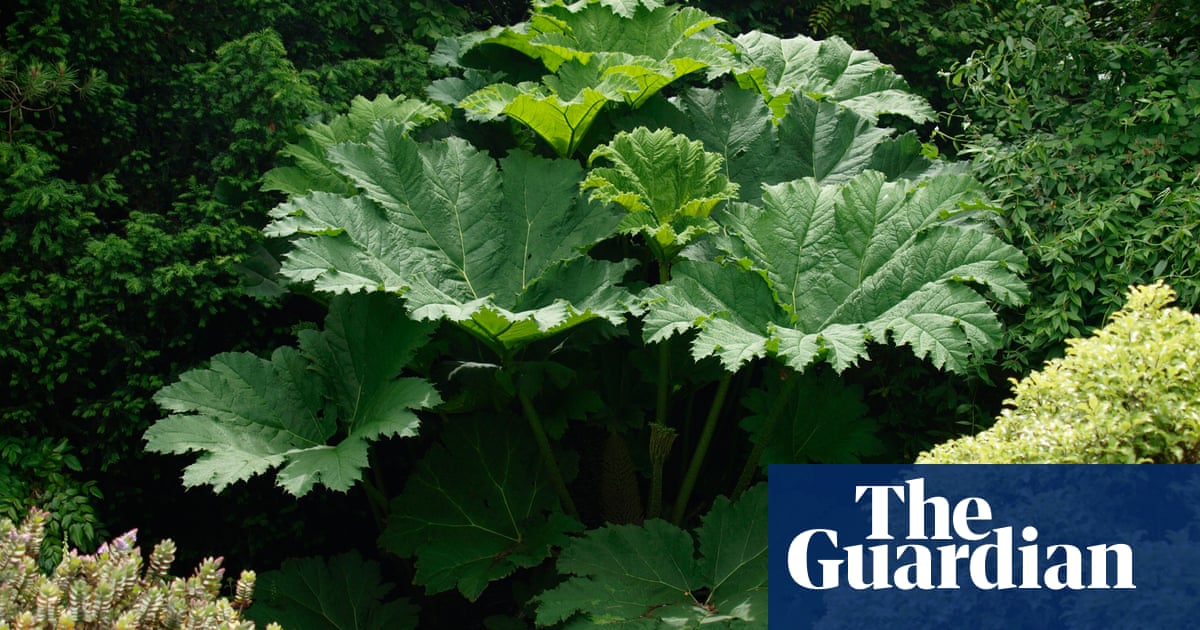
With its dramatic leaves and sprawling structure, the giant rhubarb has long been a popular garden plant, gracing the grounds of stately homes and multiple National Trust properties.
But the UK government is now to enact a ban – similar to that on Japanese knotweed – on the plant, also known as Gunnera, meaning it cannot be sold or cultivated, and those who have it in their gardens must ensure it does not spread.
It has long been believed that the giant Gunnera plants in Britain are one of two species, Gunnera manicata or Gunnera tinctoria. The former is a benign and beautiful plant originating in Brazil and Chile, while the latter is highly invasive, spreading rapidly and choking native flora. It has been illegal to sell or cultivate G tinctoria since 2017, while G manicata (or plants believed to be G manicata) has been widely available and celebrated for its exotic look.
Now a study by the Royal Horticultural Society, which involved molecular and morphological analyses, as well as a historical investigation, has revealed that G manicata appears to have been lost from cultivation not long after it was introduced. In its place, the researchers found a hybrid between G manicata and G tinctoria, which has been named Gunnera × cryptica.
This species has been found to be similarly invasive to G tinctoria and will now be banned. There are fears the widespread nature of this plant will cause problems, such as those caused by G tinctoria, where it has spread in wetter areas such a the west coast of Ireland and Scotland. It has been listed as a “species of union concern” under an EU regulation, and is now listed as being of “special concern” in the UK.
There are collections of Gunnera across the UK and it is widely planted in gardens, so the RHS anticipates significant implications for the horticultural industry.
New advice from the Department for Environment Food and Rural Affairs (Defra) has said the hybrid should be treated as a banned species, so the RHS is changing its advice to gardeners about G manicata plants, which are almost certain to be the invasive hybrid, removing them from shops, and identifying any of the hybrid plants in its gardens.
While some may be removed from RHS gardens, if any plants are retained there will be prominent signage with of the plants and advising gardeners not to plant it in their gardens. Defra says any existing plants may be retained but Gunnera × cryptica must not be newly planted or cultivated.
In drier areas, the moisture-loving plant needs a lot of watering, and this falls under the definition of cultivating, so many of the plants across the country will have to be allowed to die out.
The RHS say that if gardeners do want to remove it, it can be cut back and treated with herbicide or dug out completely. Alternatively, an easy way to stop it from spreading is to cut flower heads each summer before they set seed, then compost with care. The flower spikes can be cut close to their base with a gardening knife or pruning saw in July or August.
John David, head of horticultural taxonomy at the RHS, said: “When we began our research we were using Gunnera to look at the difficulties in differentiating between an invasive species and its non-invasive close relatives. It was therefore a surprise to find that a plant that has been a firm favourite in our gardens for its impressive size and exotic appearance, turned out to be an undetected hybrid.
“This would not have been possible without the help of botanists in Brazil and Chile, where these plants originate, as well as many others who provided material that enabled us to prove the disappearance of one species and the discovery of the new hybrid.”












